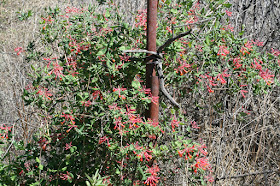Luckily I had my camera in hand, otherwise, too bad, so sad! I saw it on the honeysuckle late AM. Since we banded yesterday and only had Black-chinneds and Lucifers, I assumed it was either of those species. The first thing I noticed was the eye line, so figured it was a Lucifer. An eye line eliminated Black-chinned. Hidden by the honeysuckle and dodging among it quickly, I never could get a good look, but did think, if it was a Lucifer, it was a very dusky one. It made no sound at all except quiet wing-beats. I looked through my binoculars and saw green on the flanks. Couldn't be a Lucifer. Must be an Anna's. About the time I decided to photograph it, it flew to a nearby perch and started wiping its bill. As soon as I spied the tail, I knew it was a Broad-billed, even though I had not seen a speck of red on the lower mandible. The hummer soon disappeared, not to return. Only after enlarging this photo did even a trace of red show up.



Here's what Kelly says about the species here in W TX:
Broad-billed Hummingbird – {Below 7,000 feet} Through 2003, when this species was removed from the
Texas Review List, over half of the accepted records for the state occurred in the West Texas
region. Spring: Rare but regular visitor to the region beginning as early as March; Summer:
reported nesting along the Rio Grande in the mid-1930s; however, the presence and
documentation of multiple males, females and newly fledged juveniles in the Davis Mountains in
2008 and 2010 has finally confirmed the species nesting in Texas; Fall: much rarer than in spring;
Winter: accidental, primarily in the El Paso area; first winter record for the Big Bend area
obtained in 2014 with a female observed and photographed on 1 January, captured and banded
on 8 January, and last observed on 18 January. Very scarce during the drought of 2011/2012.
 |
| Honeysuckle at CMO |
The only other Broad-billed I've had at CMO was a young male intermittently during the month of May 2006. I imagine they aren't that rare here if you just happen to be in the right place at the right time. And in January 2014 there was a female at Lajitas (click on Broad-billed HU in index at right).
While I watched for the BBLH to return, I photographed a
Black-chinned feeding in the honeysuckle.
The redbud tree is in full bloom. Shot one Henry's Elfin butterfly in it but mostly focused my attention on the honeysuckle today. I'll try for the BBLH again in the morning and if I don't see it by about 9 AM, I'll give up on it.
 |
| Henry's Elfin in Mexican Redbud tree |
I did see a couple of odes today. Familiar Bluets, I think. But they were foraging out over the water and there was no hope of me catching one to scan. Soon though.







Congratulation on the Broad-billed...great find!!!
ReplyDeleteThanks. It made for a memorable day!
ReplyDelete